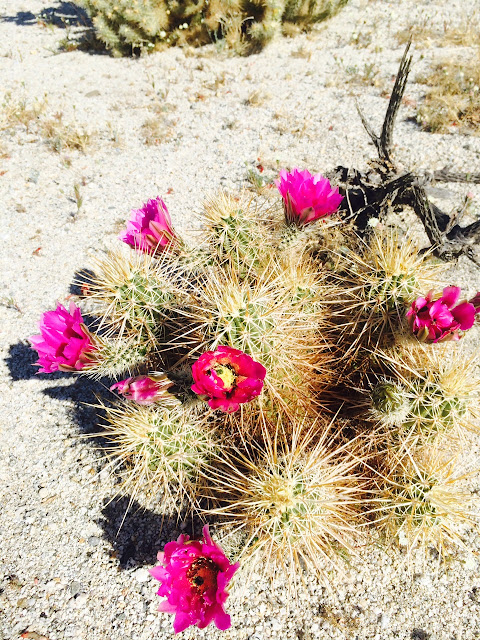Sonia and I headed out to Anza-Borrego Desert State Park this weekend. For those not familiar with the park, it is located about 35 miles west of the Salton Sea (map below). While birds were certainly a focus of this weekend, flowering cactus were our main quarry. We actually missed the peak of the action about two weeks ago, but there were still a ton of flowering spiny-things of various sorts for us to enjoy. For those that want to replicate something similar in the future (which I highly recommend), I would aim a bit earlier, say the 2nd or third weekend in March. Here is a link to a very thorough and up-to-the-day wildflower website (cactus too!) that I found particularly helpful in planning our visit. I last visited Anza in November. I included a bit more info on the park and area in that post should you want to check it out.
Anza-Borrego and surrounds
We arrived Saturday midday and took a series of short hikes to explore the area. I will say that the area around the park's Visitor's Center was uber-busy, but as soon as we got away from that area it was completely possible to carve out our own space. We ditch camped at Yaqui Wells, a short distance from the more well-established Tamarisk Grove Campground. It is also worth noting that we drove several of the park's dirt roads in our 1999 Volvo without much incident. 4-wheel drive would certainly allow access to other areas, but we could quite easily drive the first quarter mile of most of them so as to get away from the busier, paved roads. Temperatures topped out between 85-90 degrees with basically zero humidity. Anyway enough logistics, let's see some plants!
Sadly, I used the best light stalking birds with my 500mm on the 7D2, so the plant and landscape photos were all taken with an iPhone long after the best light disappeared. Next time I will be certain to bring a second body on which I would keep either a landscape or macro lens. Sonia took most of the below photos, to give credit where it's due.
Flowering cholla-type
Flowering prickly pear-type cactus
Flower Barrel-type cactus
Love hurts (same cactus as above)
Unidentified and deadly awesomeness
Me with flowering Ocotillo
A miniature Sonia with flowering Agave
Saturday night residence
Anyway, you get the general idea by now. I have spent quite a bit of
time in the desert before, but no visit was as impressive as this one. I
would highly suggest a visit to ABDSP next spring. As for birds, we had
Phainopepla, Gambel's Quail, Costa's Hummingbird, Black-throated Sparrow, Greater
Roadrunner, Verdin, Brewer's Sparrow, and Cactus Wren. The species list
is very limited but that is to be expected in a specialized
environment such as this. My goal for the weekend was to photograph
Cactus Wren, hopefully on cholla. Well, that plan failed miserably, but I
did manage this instead. I always say that all I want is one good frame per weekend; I
think this qualifies!
Cactus Wren - Campylorhynchus brunneicapillus on Agave
Canon 500mm f/4 IS v1 + 1.4x III on EOS 7D2
1/3200 at f/8, ISO 800


















